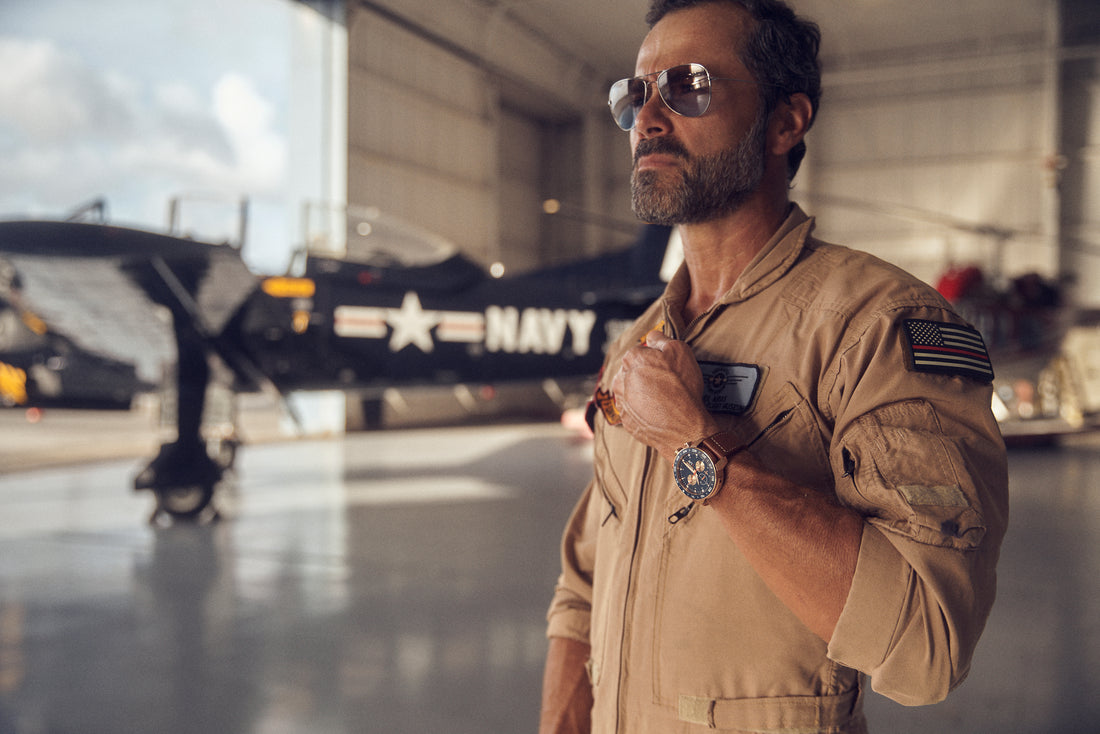EARLY DEVELOPMENT
Like its submersible relative, the diver's watch, the pilot's watch owes its greatest advances to the demands of combat. Watches have always been carried aloft. When balloons and dirigibles took to the skies, pocket watches accompanied the pilot. Because of how these lighter-than-air craft operated, pocket watches were quite satisfactory. Drifting, tethered, or even under power, the pilot was able to pull out his timepiece and use it without fear of losing control of his airship.
This changed with the arrival of heavier than-air-craft. Especially in the early days of modern aviation, removing your hands from the controls to retrieve a pocket watch could result in a variety of unpleasant acrobatics. Brazilian pilot Alberto Santos-Dumont complained to his close friend, Louis Cartier, about the difficulties he had trying to get out his pocket watch while flying. Cartier reportedly made a wristwatch for his friend and presented it to him at an air show in 1904.
Given the fact that Santos-Dumont was a regular participant at the airshows of the day, other pilots exhibited one of the earliest known examples of wrist envy.

As a result, the pilot's watch soon became a "must-have" instrument in the cockpit. And, not just for "keeping up with the Santos-Dumonts" reasons. Advances in powered flight were enabling planes to fly further and faster. With a reliable watch and a compass, pilots had the tools they needed to calculate time-speed-distance, determine when to move to the next leg of a flight, judge how much fuel was left, and generally be safer in the air.
Pilot Louis Bleriot wore a Zenith wristwatch when he made aviation history being the first to fly an airplane across the English Channel in July of 1909. Taking advantage of the feat for marketing purposes, Bleriot commented upon landing that he was very satisfied with his Zenith and would recommend it to others. The records are unclear on the point of Bleriot's comment being spontaneous or rehearsed.
WWI AND THE INTERWAR YEARS
In five short years following Bleriot's flight, Europe and most of the rest of the world was plunged into the horror of WWI. Dirigibles and observation balloons were still in use but eventually succumbed to the rapidly developing airplanes. Watches and compasses now served to guide bombers to targets to deliver their ordnance as accurately as possible.
The airplanes of WWI were often hard to control. That meant the pilot was ill-advised to take his hands off the controls to retrieve his pocket watch. The same value that leads Santos-Dumont to seek a solution carried full force into combat.
Most aerial combat during WWI occurred during the day due to lack of proper instruments and lights. Bad weather almost always grounded the planes of the time. So watches did not need large quantities of luminescence. They just needed to be easy to read. Therefore, the iconic black dial and large contrasting Arabic numerals became standard issue.
As a result of experiences in WWI, U.S. Navy captain Philip Van Horn Weems designed an independently adjustable seconds ring. This feature allowed pilots to accurately synchronize their watch with a radio time signal without stopping the sweep seconds hand. Although "hacking" watch movements to allow everyone in a combat unit to synchronize their watches to the second, the practice could result in throwing pilots off course, ruin missions, and risk the airplane and crew.
Following his successful trans-Atlantic flight in 1927, Charles Lindbergh collaborated with Weems to develop the Hour Angle system which further enabled the wristwatch to determine longitude.
The German military specified a design that set the standard for what we think of as a classic pilot's watch today. By 1936, aviation advances allowed airplanes to fly at all hours and in foul weather (although grounding in severe conditions was common). The result was the Beobachtungsuhr (B-Uhr), or Observer.

Even by today's standards, the B-Uhrs were large timepieces, measuring 55mm in diameter. This size allowed the manufacturer to use a pocketwatch movement for many reasons, prime among these immediate legibility. A large, "onion" style crown enabled the pilot to manipulate his watch wearing gloves, the same reason many diver's watch feature oversized crowns.
The movement was protected by an iron ring around the outer edge, making it anti-magnetic. Being anti-magnetic prevented interference from the radios and electrical equipment on board the aircraft.
It featured a hacking capability for synchronization. Given the solution Weems introduced, this seems counterintuitive to this writer, especially since the Germans synced their watches to a precise time signal broadcast by the military.
The leather straps were double-riveted for extra durability, and were long enough to be strapped over a flight jacket. Given the ability to fly in low light, large amount of lume were used on the Arabic numerals and the hands.
- Chaz Chazanow
Co-Founder at LIV Watches
ADVANCES DURING WWII
All the major belligerents of WWII designed and manufactured large numbers of pilot's watches for their combat airmen. Germany's B-Uhr served throughout the conflict.
Glashutte was another German company that manufactured pilot's watches. Smaller in diameter at 39mm, the movement was a chronograph that featured a flyback capability. This feature allowed the chronograph to be reset while running.
Germany was one of the few airforces to make extensive use of chronographs. It was also waterproof and had a shatter-resistant acrylic crystal.
Britain equipped its flyers with watches from a dozen Swiss companies. In 1940, all the UK watchmakers were at full capacity, making alternate sources of supply a necessity. The War Ministry supplied the specifications for the WWW, or Wrist Watch Waterproof. The requirements for the watches were simple; waterproof, have luminous hands, and use chronometer certified movements.

French watchmaker Zenith continued to manufacture their pilot's watches. Striking a neutral stance, Zenith sold its watches to both the Allies and the Axis. They used their 1939 Type Montre D’Aéronef design as the basis of their wristwatch. It featured the black dial and white Arabic numerals with the large onion-style crown at 3 o'clock.
The United States did not produce a purpose-made pilot's watch. One of the most widely produced models supplied to American forces was the A-11. Manufactured by Bulova, Waltham, and Elgin, the watch featured the required high-visibility black dial with white Arabic numerals. The manually wound movement featured a hacking function for synchronization. Some A-11s were waterproof, some were dust proof, some had luminous hands, and some did not. All had a larger crown at 3 o'clock, but not in the onion style.
POSTWAR EVOLUTION

Following WWII, the interest in pilots and military-inspired wristwatches continued to grow. Millions of fighting men, having been issued or exposed to these iconic watches, wanted to keep the look. Here is a brief look at major developments from the end of the war to near present day.
1936–IWC introduces its Special Pilots Watch
1941–Breitling introduces the Chronomat with a slide rule bezel
1955–The Breitling Navitimer, also with a slide rule, hits the wrists of pilots
The 1950s–Rolex GMT-Master built for Pan Am pilots
1992–IWC unveils its IW3711 Double-Chronograph
2005–Bell & Ross introduces the BR-01 with its instrument-inspired design
2005 and beyond–Numerous brands reintroduce their iconic timepieces from WWII
"We are proud to be a part of the history of Pilot's watches. In creating the LIV Pilot's watch, we obsessed over every tiny detail and took no shortcuts. The result is a gorgeous aesthetic with incredible functionality which continues to awe our fans."
STANDARD REQUIREMENTS FOR A PILOT'S WATCH
The requirements laid down for a pilot's watch following WWI were few and simple.
- It had to have instant readability - hence the large size and black dials with white Arabic numerals.
- An orientation triangle at the 12 o'clock position was widely used to help pilots instantly see the orientation of their timepiece and determine the correct time.
- It had to be visible in the dark - so lots of lume was required.
- It had to be easy to manipulate with gloved hands - enter the onion crown.
- It had to have premium accuracy - military users, in particular, insisted on chronograph certified movements.
- It had to be rugged - waterproof, shatter-resistant crystals, anti-magnetic treatments.
Other "bells and whistles" were added as requested or conceived by the manufacturers. Today, these same features form the basis of nearly every pilot's watch. Gone are the extra-long straps required to fit over heavy flight jackets and the size of the watch has dropped back below the 50+mm sizes common during the war. Also, chronograph certified movements are less common. New movements are accurate enough for today's needs.

LIV'S TAKE ON THE ICONIC PILOT'S WATCH
LIV Watches introduced the P-51 Pilot's Watch in 2018. This premium Swiss-made watch pays homage to the best air superiority fighter of WWII, the P-51 Mustang. Equipped with a Rolls-Royce Merlin v-12 engine, six 50-caliber machine guns, the ability to carry rockets and bombs, and the fuel capacity to accompany Allied bomber formations to targets in Germany and back, this marvelous airplane was a final nail in the coffin of the Luftwaffe fighter forces. The LIV P-51 Pilots Watch would certainly find favor with the airmen of WWII.

Titanium and ceramic case construction greatly reduces the felt weight. The accuracy and feature set of the Valjoux 7750 chronograph would meet the most demanding mission timing and coordination demands. As an automatic movement, a large crown for manual winding in flight would be unnecessary, something these aviators would appreciate. Rugged and easy to read in all lighting conditions thanks to copious of premium BG-W9 lume.
LIV P-51 TITANIUM SWISS PILOT CERAMIC AUTO CHRONOGRAPH
Movement–25 Jewel Swiss Automatic Chrono, ETA 7750
Case–Titanium
Case Back–Screwed Down, Skeleton Sapphire Crystal
Bezel–120-click Rotation, Black Ceramic Insert with BG-W9 Luminescent
Crystal–Scratch Resistant Sapphire

Crown–Oversized & Screwed Down
Water Resistance–100m
Dimensions–46mm Diameter; 15.9mm Height; 23mm Lug/Strap Width
Production–Swiss Made, Limited to 500 with Individual Serial Numbers
BEHIND THE PIECE


